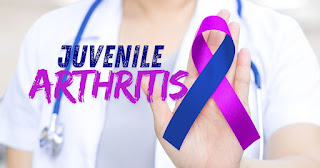Juvenile Arthritis Awareness Month: A Comprehensive Guide
Juvenile Arthritis (JA) is a term encompassing a variety of autoimmune and inflammatory conditions that can develop in children under the age of 16. Affecting nearly 300,000 children in the United States alone, Juvenile Arthritis poses significant challenges for young patients and their families. To raise awareness and promote early diagnosis and treatment, July is dedicated to Juvenile Arthritis Awareness Month, symbolized by the colors blue and purple. This article answers key questions about Juvenile Arthritis, its symptoms, diagnostic criteria, and the importance of the awareness month.

Juvenile Arthritis Awareness Month |
What is Juvenile Arthritis?
Juvenile Arthritis is not a single disease but a term that refers to various types of arthritis affecting children. The most common types include Juvenile Idiopathic Arthritis (JIA), Juvenile Dermatomyositis, Juvenile Lupus, and Juvenile Scleroderma. These conditions cause joint inflammation and stiffness that can lead to pain, swelling, and potential damage to joints if not treated promptly. Juvenile Arthritis can also affect the eyes, skin, muscles, and gastrointestinal tract.
What Month is Juvenile Arthritis Awareness Month?
Juvenile Arthritis Awareness Month is observed in July. This month-long campaign aims to educate the public about the realities of living with Juvenile Arthritis, advocate for better treatments and support for affected children, and fundraise for research into more effective therapies.
What is the Color for Juvenile Arthritis Awareness Month?
The colors representing Juvenile Arthritis Awareness Month are blue and purple. These colors are used in various campaigns and events throughout July to symbolize support for children living with this condition and to promote the cause.
Show your support for Juvenile Arthritis Awareness Month with this vibrant blue and purple t-shirt. Featuring a powerful message to raise awareness, this t-shirt is perfect for spreading the word about the challenges faced by children with arthritis. Made from comfortable, high-quality material, it’s ideal for everyday wear or special awareness events. Help make a difference and support the fight against Juvenile Arthritis today.
 |
| Juvenile Arthritis Awareness Month |
What are the Symptoms of Juvenile Arthritis?
The symptoms of Juvenile Arthritis can vary depending on the specific type but commonly include:
- Joint Pain and Swelling: Persistent joint pain and swelling, especially in the knees, ankles, and wrists.
- Stiffness: Joint stiffness, particularly in the morning or after periods of inactivity.
- Fatigue: Chronic fatigue and tiredness.
- Fever: Recurring fever without an apparent cause.
- Rash: A skin rash that can accompany some forms of Juvenile Arthritis.
- Eye Problems: Eye inflammation or uveitis, which can lead to vision issues if untreated.
- Growth Problems: Slower growth or uneven limb growth.
What are the Diagnostic Criteria for Juvenile Arthritis?
Diagnosing Juvenile Arthritis involves a combination of medical history, physical examination, and various tests to rule out other conditions. Key diagnostic criteria include:
- Duration of Symptoms: Symptoms must persist for at least six weeks.
- Age of Onset: Symptoms must begin before the age of 16.
- Physical Examination: Checking for joint inflammation, swelling, and tenderness.
- Blood Tests: Tests for markers of inflammation (e.g., ESR, CRP) and specific antibodies (e.g., ANA, RF).
- Imaging Tests: X-rays, MRI, or ultrasound to assess joint damage and inflammation.
- Exclusion of Other Conditions: Ruling out other diseases with similar symptoms, such as infections, bone disorders, or other autoimmune diseases.
The Importance of Juvenile Arthritis Awareness Month
Juvenile Arthritis Awareness Month in July plays a crucial role in highlighting the impact of this condition on children and their families. Early diagnosis and treatment are essential for managing symptoms, preventing joint damage, and improving the quality of life for young patients. Awareness campaigns encourage parents, caregivers, and healthcare providers to recognize the signs of Juvenile Arthritis early and seek appropriate medical intervention.
By donning blue and purple, participating in events, and spreading information, we can support the children affected by Juvenile Arthritis and contribute to ongoing research and better treatment options. Together, we can make a difference in the lives of these young warriors.
